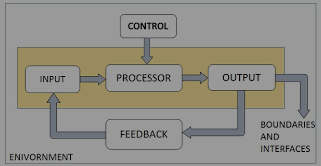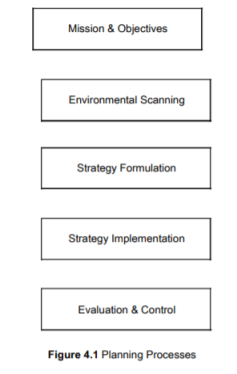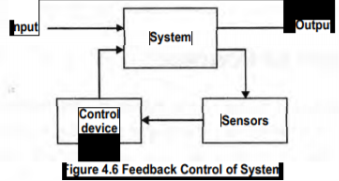Unit 3
Concepts of planning & control
A system is an orderly grouping of interdependent components linked together according to a plan to achieve a specific objective.
There are three basic implications to a system:
Features:
Components of a System
Input | Capturing and Assembling |
Processor | Transformation |
Output | Value to the user |
Controls | Guides the system |
Feedback | Actual against Standard |
Environment | Super System |
Boundaries and Interface | Limits when interfaces with another |

Components of System
To effectively deliver the information needed to decision makers, Management Information Systems need to have the necessary components to collect, process, store and retrieve the information whenever it is needed.
To achieve this, these systems use the following four components:
5. Control
Consider the process in the forms of steps, that is control in relation to management may appear like this:
A plan is a predetermined course of action to be taken in the future. It is a document retaining the details of how the action will be executed and it is made against a time scale. The goals and the objective that a plan is supposed to achieve are the prerequisites of a plan. The setting of the goals and the objective is the primary task Management without which planning cannot begin. Planning means taking a deep look into the future and assess the total business environment and taking a suitable action to meet any eventual requirements which further means generating the courses of action to meet the most desired result.
Planning is a dynamic process. As the future becomes the present reality, the action decided earlier may require a change. Planning, therefore, calls for a continuous assessment of the predetermined course of action versus the current requirements of the environment. The essence of planning is to see the opportunities and the threats in the future and predetermine the course of action to convert the opportunity into a business gain, and to meet the threat to avoid any business loss. Planning involves challenging decisions, one dependent on the other, since it deals with a long term period. Successful implementation of a plan means the execution of 'these decisions in proper manner one after another. Planning, in terms of future, can be long-range or short-range. Long-range plan: is for a period of five years or more, while short-range planning is for one year at the most. The long-range planning is more concerned about the business as a whole, deals with subject like the growth and the rate of growth, the direction of business, establishing some position in the business world by way of corporate image, business share and so on. On the other hand, short-range planning is' more concerned with attainment of the business results of the year. It could also be in terms of action certain business tasks, such as lunching of a new product, starting a manufacturing:- facility, completing the project, achieving intermediate milestones on the way to attainment of goals. The goals relate to long-term planning and the objective relate to short-term planning. There is a hierarchy of objectives which together take the company to the attainment of goals. The plans, therefore, relate to the objectives when they are short-range and to goals when they are the long-range .Long-range planning deals with- resource selection, its acquisition and allocation. It deals with the technology and no with the methods or the procedures. It talks about the strategy of achieving the goals. The right strategy improves the chance of success tremendously. At the same time, a wrong strategy means a failure in achieving the goals. Corporate business planning deals with the corporate business goals and objectives. The business may be a manufacturing or a service, it may deal with the industry or trade may operate in a public or a private sector; may be a national or an international business. Corporate business planning is a necessity in all cases .Though the corporate business planning deals with a company, its universe is beyond the company .Business plan considers the world trends in the business, the industry, the e - 2.--logy, the international markets, the national priorities, the competitors, the e- - -s plans, the corporate strengths and the weaknesses for preparing a corporate Imo. Planning therefore, is a complex exercise of steering the company through the mr ities, the difficulties, the inhibitions and the uncertainties towards the iamment of goals and objective.
Planning helps management understand the current situation. This in turn allows management to plan for the future. In a world of rapid change, it is becoming imperative management to think strategically (plan for the future). And since the rate of change seems to be escalating, the importance of strategic planning continues to grow. In 1 the best managed companies tend to engage in continuous strategic planning. Sc organizations have intuitive thinkers who almost seem to see into the future. Therefore, strategic planning is a way of preparing for the future by attempting to simulate future. Planning has a tendency to force people to think about the future. This is extremely important since many organizations are inward thinking, focusing too much on i short-term. Planning looks at the long-term which is how organizations survive thrive. It has been proven that organizations that focus on the long-term throb strategic planning outperform organizations that lack long-term planning. Consequent one of the benefits of planning is long-term performance and growth. Another benefit planning is communication. Plans communicate the intentions of management employees, shareholders, and others. A simplified view of the planning process is shown by the following diagram:

There are four types of computational support needed for the analysis prepal planning, the preparation of the plans and the output of the results:
1. An analysis of historical data to obtain relationship useful for projection.
2. Various projection and forecasting techniques to estimate future value.
3. Computations internal to the plan and computation required for outputs.
4. Output of the results in a meaningful planning format.
This computational support can range from sophisticated techniques to a simple spread sheet computational procedure.
Historical Data Analysis Technique
Historical data is analysed to discover patterns or relations that will be useful for projecting the future values of significant variables. When quantitative relations are not sufficiently stable to use, forecasting data analysis is useful for input into judgmental forecast.
Historical extrapolation techniques
Historical data describes the past planning that involve the future estimating generally based on analysis of past history combined with various technique to genera/ data for planning purposes.
Financial planning computation
Models that involve financial plan need to provide for various computation and analysis commonly required for measuring or evaluating profitability. For eg: depreciation computation rate of return analysis and break even analysis.
Depreciation: It is a significant computation in most financial planning. It affects profit computations because it is an expense, and it affects cash flow because of its impact or' taxes. There are several methods for computing depreciation, all of which should be available to the planner. These methods are straight line, double declining-balance, sum of the years’ digits and production.
Rate of return analysis: It is a method for computing the profitability of an investment. It takes into account the timing of the investment and the cash flows stemming from it. There are several methods for computing the rate of return which should be checked at the start of the planning model.
Break-even analysis: It is a fairly simple but very useful computation for determining the volume of activity at which there is no loss or profit.
Control consists of procedures to determine deviations from plans and indicates corrective action. Every major organizational function has a set of controls associated with it.
1. Control in Systems
For Control purposes, there is basic model in which outputs from the system are compared with the desired output(standard),and any difference causes an input to be sent to the process to adjust the operations so that output will be closer to the standard. Feedback which seeks to dampen and reduce fluctuations around the standard is termed negative feedback. It is used in feedback control loops. Positive feedback reinforces the direction in which the system is moving. .In other words, positive feedback causes the system to repeat or amplify an adjustment or action. For example, a programming supervisor may have learned about the use of modular program structure. After trying on a small project with good results (positive feedback), the supervisor tries it on a larger project, again with good results. The supervisor may continue this until all programming is done in that way (a steady state) or until projects are found for which it does not work.

Feedback in which the system changes its operation is not the only adjustment an organizational system may make. In response to feedback, the organization may change its standards (objectives, goals, purposes, etc.). In the example above, the positive results use of modular program structure may result in an adjustment of the standard for programmer performance. Since organizations are goal-directed and self-organizing, a change in goals may often lead to changes in the system to achieve the new goals.
Nature of control in the organisation
Management control is a systematic effort to set performance standards with planning objectives, to design information feedback systems, to compare actual performance with these predetermined standards, to determine whether there are any legal actions and to measure their significance, and to take any action required to assure that all corporate resources are being used in the most effective and efficient way possible in achieving corporate objectives.
1. Establish the Standards
Within an organization's overall strategic plan, managers define goals for organizational departments in specific, precise, operational terms that include standards of performance to compare with organizational activities. However, for some of the activities the standards cannot be specific and precise.
Standards, against which actual performance will be compared, may be derived from the last experience, statistical methods and benchmarking (based upon the best industry practices). As far as possible, the standards are developed bilaterally rather than top management deciding unilaterally, keeping in view the organization's goals.
Standards may be tangible (clear, concrete, specific, and generally measurable) - numerical standards, monetary, physical, and time standards; and intangible (relating to human characteristics) - desirable attitudes, high morale, ethics, and cooperation.
2. Measure Actual Performance
Most organizations prepare formal reports of performance measurements which are both quantitative and qualitative (where quantification is not possible) which the managers review regularly. These measurements should be related to the standards set in the first step of the control process. For example, if sales growth is the target, the organization should have a means of gathering and reporting sales data. Data can be collected through personal observation through management by walking around the place where things are happening, statistical reports (made possible by computers), oral reporting (through conferencing, one-to-one meeting, or telephone calls), written reporting (comprehensive and concise, accounting information - normally a combination of all. To be of use, the information flow should be regular and timely.
3. Compare Performance with the Standards
This step compares actual activities to performance standards. When managers read computer reports or walk through their plants, they identify whether actual performance meets, exceeds, or falls short of standards. Typically, performance reports simplify such comparison by placing the performance standards for the same reporting period alongside the actual performance for the same period and by computing the variance—that is, the difference between each actual amount and the associated standard. The manager must know of the standard permitted variation (both positive and negative). Management by exception is most appropriate and practical to keep insignificant deviations away. Timetable for the comparison depends upon many including importance and complexity attached with importance and complexity.
4. Take Corrective Action and Reinforcement of Successes
When performance deviates from standards, managers must determine changes, if any, are necessary and how to apply them. In the productivity and centered environment, workers and managers are often empowered to evaluate own work. After the evaluator determines the cause or causes of deviation, he or she take the fourth step— corrective action. The corrective action may be to maintain status quo (reinforcing succ correcting the deviation, or changing standards. The most effective course may prescribed by policies or may be best left up to employees' judgment and initiative. corrective action may be immediate or basic (modifying the standards themselves)
References-